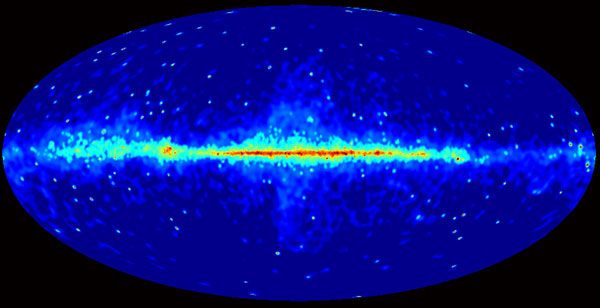Measure the distance between stars
For the first time, American astronomers estimated the average distance between stars in the universe.
Stars can burn out and die, but its light lasts forever. All the light that comes from stars still lurks somewhere in the universe, a phenomenon known as galactic background light (EBL).

Synthetic universe map from gamma radiation.Red light band represents the Milky Way
This is a kind of "mist" light, blurring the light from distant stars passing through it, like light from the lighthouse blurred in the fog.
Now, for the first time, astronomers can measure all EBL and calculate the distances of stars in the universe.
According to the Science report, the average density of stars in the universe is about 1.4 / 100 billion light-years. That means the average distance between stars is 4,150 light years.
To measure EBL, astronomers need a form of 'directions' to help them determine how much light has been lost. And according to Stanford University chief Marco Ajello, they chose blazar, galaxies emitting a large amount of gamma-ray radiation, capable of penetrating 'fog' effectively.
In the past four years, NASA's Gamma Fermi ray space telescope scanned the entire universe to find blazar, and identified more than 1,000 objects, from which to measure the combined mass of stars in the history of the universe.
- How to measure the distance through the center of the Milky Way?
- Decode the distance from the Earth to the Sun.
- Laser ruler
- Orion Nebula, the cradle is full of disturbance
- Jupiter-like planets orbiting one of the smallest stars
- 9 interesting things about stars
- The star explodes near Earth, destroying giant sharks
- Detecting super-fast star systems disrupts conventional physics theory
- Explain the mystery of missing stars in the universe
- Decoding super-fast stars in 'Ngan river'
- Detects 5 oversized stars on galaxies
- Breathtaking the sight of the stars 'circus' in the sky
 Van Allen's belt and evidence that the Apollo 11 mission to the Moon was myth
Van Allen's belt and evidence that the Apollo 11 mission to the Moon was myth The levels of civilization in the universe (Kardashev scale)
The levels of civilization in the universe (Kardashev scale) Today Mars, the sun and the Earth are aligned
Today Mars, the sun and the Earth are aligned The Amazon owner announced a secret plan to build a space base for thousands of people
The Amazon owner announced a secret plan to build a space base for thousands of people 9 billion light years away, 'space hole' facing Earthlings
9 billion light years away, 'space hole' facing Earthlings  Simulating Einstein's formula, scientists prove that light can create matter
Simulating Einstein's formula, scientists prove that light can create matter  How do animals see the world?
How do animals see the world?  How do real life invisibility cloaks work?
How do real life invisibility cloaks work?  Double quasars travel through 10 billion years to Earth, about to merge into a monster
Double quasars travel through 10 billion years to Earth, about to merge into a monster  What happens after humans travel faster than the speed of light?
What happens after humans travel faster than the speed of light? 